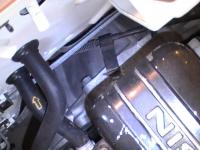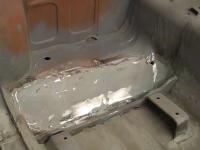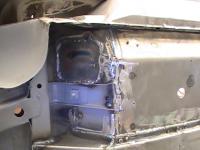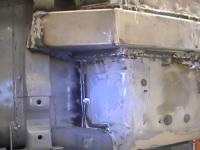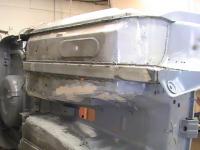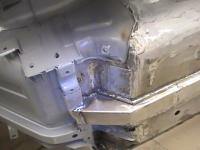Everything posted by Seppi72
-
New Seats are in!!!!!
What mounting point did you use for the submarine belt: drill a new hole in the floor and weld in a nut, drill into the front seat bracket, etc? I've got a 5-point harness that I'll be putting in my car this spring and need to know.
-
Removing White Hazy Marks From Glass
I described my issues with AGR W/S parts in another thread a month or so ago but here's a reprise. Las year, I bought a W/S from Black Dragon. It was PPG band but marked made in China. The damn thing broke on me while I was storing it. Afterwards, I checked and the glass plies were considerably thinner than I believe they should have been. At least when I was at L-O-F and we were making such parts for both OEM and AGR channels, the glass was thicker. I would call a couple of your local glass suppliers and see what brand they can get, the cost and, importantly, the construction; meaning the thicknesses (in mils) of the glass/PVB/glass sandwich. It should be something like 80/30/80. Even better is 90/30/90. The two glass plies are "always" the same thickness as it doesn't make sense to use differing thicknesses considering how the parts are made and how they have to match up. I'd bet that the Chinese PPG W/S (long ago trashed) was a 70/20/70 - the b*st*rds. Call up Black Dragon too and ask them for the make and construction of the W/S parts they have in stock now. If they claim they can't do that, tell them to measure one ply and then the overall thickness. You can deduce the construction from that assuming equal ply thicknesses. I'd be curious to know all this info as I STILL need a freaking W/S for my rebuild project.:stupid:
-
Roll bar
If you're really serious about side impact protection, you can do what I'm planning to do with my '72 rebuild project. I removed the internal door bolster bar (you have to drill out two welds at one end of the door - I can't recall whether it's the front or rear) and I'm gong to have two strips of 1/4" steel welded in about 1/3 of the distance across and parallel to the outer edges. This will give more intrusion resistance. I don't know how "tall" these strips will be as I have yet to check the clearances involved with the window and lock mechanisms. Short of a cage or abandoning the ability to lower a window, this is the best way to improve side protection without limiting ingress and egress. If you don't care about ventilation (either window up all the time or no windows), you could just weld some 1/4" wall steel tubing inside the door.
-
Removing White Hazy Marks From Glass
Carguyinok: Wow. It makes no sense to me that anyone would make laminated glass for anything other than the windshield (W/S in glass lingo). The cost of laminated is at least 4 or 5 times that of the equivalent tempered part. In addition, I'm not sure that laminated backlight (B/L) glass could handle the heat produced by the defroster grid without serious issues. The plastic in a laminated part is polyvinyl butyrate (PVB) and PVB absorbs moisture. It, therefore, has to be dried before the lamination process or else the heat required to get it soft and sticky so that it glues the two plies of glass together will cause the formation of bubbles (from the absorbed water). After manufacture, and over time, the PVB will reabsorb moisture along the exposed edges of the part unless they are sealed off from the atmosphere during the installation process. If the saturated PVB gets heated above, say, 200 F, you will see bubbles form again. And the local temperature of a defroster grid wire is well above that threshold. As for identifying glass, there will be a mark or logo in the lower corner of every piece that gets put on a car destined for the U.S. (and probably most other first-world countries) that identifies the maker and whether it is AS1 (Approved Safety type 1 = laminated) or AS2 (tempered). I can't recall who made the OEM glass for the 240Z, but it might have been NSG (Nippon Sheet Glass Co, Ltd.). I DO know that all OEM glass was made in Japan so if you see a PPG logo or something else, it's aftermarket or AGR (automotive glass replacement). Sorry about all the abbreviations, but I spent the time to learn them and I don't get too many chances to use them anymore.
-
Removing White Hazy Marks From Glass
The only "safety" glass (properly referred to as laminated glass) in a Z is the windshield/windscreen. All other glass is tempered glass which is a single plate that has been heat treated such that the surface is in compression and the innards are in tension. When a crack is initiated in tempered glass, it propagates rapidly in many directions and makes the glass appear to "explode" into thousands of, one would hope, harmless particles instead of long, sharp shards. I worked with both kinds of glass for 8 years doing R&D at Libbey-Owens-Ford Co. (now Pilkington) in Toledo, OH.
-
intake/exhaust studs and bolts?
According to the Section 3 illustration, there are at least three different studs used on an L24 head's breathing side. They are numbers 12-14 in the figure. They are all 1.25 thread. What I can't tell from this is how they differ and exactly how many of the 12s and 14s are used. There is only one #13 used for the rear sling (part 26). The fiche calls for 6 of the #14s on both the L24 and L26 so maybe those are just the upper row of studs. But it calls for 10 of the #12s on an L24 but only 4 of them on an L26. WTF?:stupid: I can't make much sense of the equivalent illustration for an L28E head. Even though the fiche is screwy, it appears that all the "hangers" on a factory L head are studs and no bolts are used. Almost 40 years later, how many cars are OEM? I know that mine aren't. So, regardless of what stud you use, if it has enough thread so that you can tighten down the accompanying nut, you should be in good shape. S30fiche3-1.PDF
-
Speedo cable bracket
I'm reinstalling everything in my car now that it's back from crash repair and I'm trying to figure out exactly where a bracket that surrounds the speedo cable is supposed to mount. It almost looks as though it's supposed to be held by the tranny-to-block bolt that's next to it in the photo. Does anybody know if that's correct? BTW, do any of you have or know of a gallery that's full of engine bay shots from various angles? That would be immensely helpful as the FSM and the club's parts microfiche CD aren't exactly lavish with illustrations of how things look for real.
-
Floor Rear Frame Repair?
I tried to post this yesterday, but had connectivity issues. My car (HLS30-46372) is an early '72 (9/71 build date) but it was assembled with leftover '71 parts, such as horizontal defroster wires and non-retractable selt belts (no idiot light in the fuse box cover either). However, the chassis had pockets for the belt retractors. In fixing the floor rust I went with pans from Charlie Osborne (Zedd Findings) but I chose Bad Dog Parts frame rails and rear extensions because they are much thicker and I want as much stiffness under my butt as possible. I decided to have the seat belt retractor pockets removed (a) because they are unnecessary for my purposes and ( because they seem to provide a lovely spot for damp crud to collect and start the rust monster up all over again. You can also see in the pix that we simply used flat panels to bridge the gaps between where the floor pans ended and the good chassis metal resumed. A bit of the work is out of sight now as there's a layer of Sherwin-Williams Duraglas over the interior work.
-
Roll bar
I agree with the other posters. I put an AutoPower SCCA roll bar in one of my '72 cars and have another one ready to put into the other when I get to the point of reassembling it. It gives a lot of peace-of-mind when driving on roads that have either deep ditches or drop-offs. Fortunately, I haven't tested THAT feature yet.:laugh: So far, I have specialized only in nose-first offroading. It also stiffens up the rear so a strut-mounted cross brace isn't needed. It provides great attachment for the shoulder belts of my 5-point harness and looks damn with the Corbeau CR1 seats in the car.
-
Floor Rear Frame Repair?
I had this same issue with my '72 and, even though I was using Charlie Osbourne's (Zedd Findings) floor pan parts, they didn't go back as far as the rot. I ended up bending some replacement panels and adding them in. I'll be able to add in some pix tomorrow if you're interested.
-
Black Dragon Automotive
Stephen: I have the club's parts CD, which is inadequate in several areas, but I was until now unaware of Nissan FAST. I just read a bit about it in nIssanfourms.com (http://www.nissanforums.com/general-discussion/92323-nissan-fast-software.html) and am uncertain if installing it is worth my while. Can Nissan FAST be a useful parts locating tool for us S30 lovers?
-
Reasonable cost for porting
I have several L6 heads and I'm going to use one of them on a stroker build. I want to get the head ported and polished and don't know whether to farm it out to a person accomplished in this process or take the time to learn how to do it myself (probably learning on a broken head and then going to work on the desired one). If I were to farm it out, what would be a reasonable price to pay for this? Alternatively, how many hours would it take for a novice-to-middling "porter" to do an entire head? I'm sure several members have gone down both of these routes and hope to benefit from those experiences.
-
Plastic welders
Just to address your experience when gluing your panels, here's something to consider. A glue like ABS (or PVC) cement works by dissolving the plastic in the workpieces. If you have a truly clear ABS glue; i.e., transparent and colorless, it does NOT contain any ABS. If it did, it would, at least, have to be translucent if not opaque. Thus, using that glue would simply dissolve the plastic surfaces that it touched. Polymer molecules would entangle forming connections between the various pieces, but it would only be a thin surface thing on something such as an interior panel crack. Black ABS glue has some black ABS already dissolved into it. Thus, when it eventually dries, it not only has those molecules from the part surfaces, it also has the ones that were in the glue to begin with. You therefore have more solid material in that joint.
-
Plastic welders
I cannot disagree with your desire to hear from more folks about plastics welding. I've worked in polymer and plastics R&D for almost 30 years now (my god, am I really that old?) and I have a pretty good idea of what these materials are like and how they respond to outside "forces." The problem with plastics welding is that, just as with metal welding, you need to have experience to be good and most of us generally S-U-C-K at welding because we lack that experience.:sleepy: I certainly know that I do and I am thankful that I have a greatly experienced body guy to do my welding for me. The thing to remember about plastics is that all of them soften to a greater or lesser degree as they are heated - amorphous polymers like ABS and PVC soften much more than semi-crystalline ones like PP or nylon - which is something that is not a significant issue when welding metals simply because metals have much greater initial stiffness (modulus). Plastics also have much, much poorer thermal condiuctivity than do metals. So, if you take too long to get your plastic welding rod and workpieces up to the proper temperature using the typical hot air source, you run the risk of gravity causing the workpieces to distort. In fact, the best way to weld plastics is to use a plasma discharge torch that heats a stream of plastic powder (appropriate to the base plastic, of course) and blows it onto the workpieces as it almost instantaneously heats only their surfaces. All the melted plastics become quite intimate and you get a weld quickly and without the same risk of distortion. But only high-powered plastics welding operations could afford to have such plasma welders, so we hobbyists are screwed.
-
Plastic welders
These are made of either mineral-filled polypropylene (PP) or glass/mineral-filled nylon 66. If it's PP, there's no glue that will adhere unless you etch the surface with a corona discharge (not in anyone's tool kit). If it's nylon, you should be able to get an epoxy to stick. Thus, it sounds like it's PP. You will have to weld this or fabricate a plastic strap to bridge the crack and screw it into the shroud.
-
Plastic welders
Use the ABS cement, then scuff the backside and apply your fiberglass patch. That's the best way to, first, secure and seal the existing crack and, second, prevent it from ever starting to come apart again. You can use a crayon to fill in whatever vestige of a crack remains on the show surface: 1. trace crack with crayon, 2. heat with a hair dryer to melt wax, 3. allow to cool, 4. wipe off any excess. Eventually, Nissan figured out that the interior panels had to be thicker and they made the switch.
-
You will never guess what I found . . . .
I bought floor pans from Charlie Osborne in Canada and frame rails from Big Dog. I am immensely pleased with both purchases.
-
Windshield
It's only because I worked in the glass industry for about 8 years that I stay on top of these things. And LOF was (and is) the main competitor to PPG. Note that I'm not saying all PPG W/S parts are that thin; only the AGR one that I got through Black Dragon (and they may use different suppliers over time too). In fact, PPG has/had several plants in the U.S. that make OE and recent AGR parts. But it obviously has a Chinese connection (I don't know if PPG owns a factory there or not) that allows at least some glass made there to be branded as PPG. Also, be aware that PPG sold its glass division in late 2007 to Platinum Equity, a holding company based in Beverly Hills, CA. That, along with the more recent near-collapse of the domestic auto industry probably means quite a few U.S. jobs will be shed and even more items - perhaps even OE glass - could be coming here from China. However, the OEMs dictate exactly how thick glass is that they assemble into new vehicles. It's the AGR parts that can become a crap shoot.
-
Windshield
You need to be aware that some (all?) aftermarket glass replacement (AGR) W/Ss are a LOT thinner than the original equipment (OE) W/Ss. I found this out the hard way when I piggybacked a W/S order through Black Dragon with a friend. We each ordered one to save on freight. He needed his right away. I didn't need mine right then and there. The box from Black Dragon was well-made and the contents had been secured with foam-in-place urethane. However, both W/Ss were cracked o delivery. Replacement parts arrived OK later on. However, I managed to crack my W/S right down the center when I was putting it in storage and I used to work in R&D for Libbey-Owens-Ford Glass Company in Toledo, OH. I though I knew how to properly handle laminated glass. On inspection, the PPG AGR W/S (made in China) was noticeably thinner than any of the OE parts I have. Typically, a W/S is characterized by the three thicknesses (in mils) involved: outer ply, safety ply, inner ply. I typical W/S would be something like a 90/30/90. The AGR W/S is more like a 70/25/70. So, the take-home for everyone is to ask the supplier for the thickness of the W/S. If it's 0.170" or less, watch out or be careful.
-
It happened.....today :(
Alicia: As someone who recently crashed his 240 at speed and did a pretty good number on the front end, I feel your pain. I don't know your circumstances, but, all in all, the damage doesn't look to be too severe. I would think that almost any body person with some experience would be able to pull the panel and mostly "hammer and dolly" the metal back to close to original condition. You'll do him/her a favor by taking out the interior trim pieces beforehand. At worst, a studs welded to the metal would allow a slide hammer to do a lot of the work too. The studs get ground off after the pulling. A minimal amount of Bondo should be required and, indeed, the repairer might opt to use Duraglass underneath Bondo to smooth things out and prevent any lifting due to expansion/contraction differentials as the years go by. I hope you're able to get your car repaired quickly because it's your DD. I'm fortunate that I can allow mine to linger in the shop all winter.
-
What Other Z/Datsun would/do you own and why?
I already own two S30s and, if I didn't live in the land of snow and road salt, I'd have a 510 2-door as my daily driver. I think it has the quintessential look of a family car.
-
Pulled the engine/tranny combo
The frame repair is proceeding and the entire car will be repainted before the engine/tranny goes back in. I am already adding a 6-1 MSA header to the engine, but I'd like to know what else I could (should?) do while it's out and accessible. This is a Rebello L28 with SUs built in the late 1980s and it runs like a champ. For instance, I'm going to repaint the block and oil pan. I'm wondering if something like replacing the freeze plugs would be worth the effort. Many of you have been in this position before and I'd just like to know what you did.
-
Pulled the engine/tranny combo
As many of you know, I crashed one of my '72s early in September and bent the left front frame rail fairly well. We've finally begun the repair process and the first action was to pull the engine/tranny combo, which we did on Saturday. It is from this activity that I have a question. I was the designated "under-the-car" person for this operation and when we started to pull up on the assembly, as soon as we got some amount of tilt on it, gear oil poured out the rear. It's been years since I pulled the engine tranny combo (or maybe I never have and only think I have) and I simply don't remember if this is to be expected or whether this indicates a bad seal that needs to be attended to. This is a ZX 5-speed unit. Any and all advice and slaps upside my head are appreciated.
-
Dyno Chart
I'd never thought about this upgrade before but I'm wondering how you make a head designed for the L24 pistons (86 mm ?? diameter) work with the L28 pistons (89 mm)? Perhaps it's not an issue if the piston doesn't rise above the gasket stack height?
-
Dyno Chart
A relatively flat torque curve and a broad HP curve. Certainly looks like something you can work with. I assume these are engine-only and not rear wheel curves. Now I'm dying to get my Rebello 2.8 on a dyno. Too bad I crashed the car two weeks before I had my chance this year.:disappoin





 Subscriber
Subscriber
